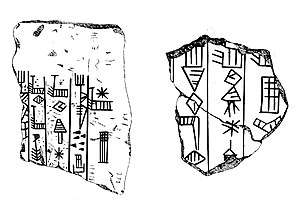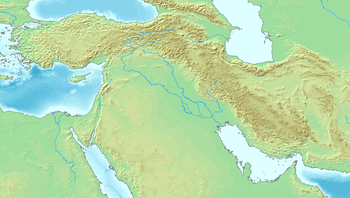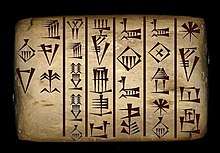Enshakushanna
Enshakushanna (Sumerian: 𒂗𒊮𒊨𒀭𒈾, en-sha3-kush2-an-na),[1] or Enshagsagana,[2] En-shag-kush-ana, Enukduanna, En-Shakansha-Ana, was a king of Uruk around the mid-3rd millennium BC who is named on the Sumerian King List, which states his reign to have been 60 years. He conquered Hamazi, Akkad, Kish, and Nippur, claiming hegemony over all of Sumer.
| Enshakushanna 𒂗𒊮𒊨𒀭𒈾 | |
|---|---|
| |
 Fragments in the name of "King Enshakushanna" (𒈗 (...) 𒂗𒊮𒊨𒀭𒈾). | |
| Reign | c. 2400 BCE |
| Successor | Lugal-kinishe-dudu |
| Dynasty | Second Dynasty of Uruk |
Titulature
He adopted the Sumerian title en ki-en-gi lugal kalam . (𒂗 𒆠𒂗𒄀 𒈗 𒌦),[3][4][5] which may be translated as "lord of Sumer and king of all the land" (which possibly implies "en of the region of Uruk and lugal of the region of Ur"[6]), and could correspond to the later title lugal ki-en-gi ki-uri "King of Sumer and Akkad" that eventually came to signify kingship over Mesopotamia as a whole.
Inscriptions
Several inscriptions of Enshakushanna are known.[7] A dedication tablet in his name is known, now in the State Hermitage Museum, St. Petersburg, Russian Federation:[8]
Dedication tablet by King Enshakushanna, State Hermitage Museum, St. Petersburg, Erm 14375 (reconstitution).[9]
𒀭𒇽𒆪𒊏 / 𒂗𒊮𒊨𒀭𒈾 /𒂗 𒆠𒂗𒄀 / 𒈗 𒌦𒈣 / 𒌉𒂍𒇷𒇷𒈾 / 𒂍𒉌𒈬𒈾𒆕
DLU2-KU-ra / en-sha3-kush2-an-na / en ki-en-gi / lugal kalam-ma / dumu e2-li-li-na#? / e2-ni mu-na-du3"For ... (unknown god): Enshakushanna, lord of Sumer and king of all the land, son of Elilina, built the temple for Him."
The inscription states that his father was "Elilina", possibly King Elulu of Ur.[12]
An inscription reports that "When the gods commanded (Enshakushana), he destroyed Kish... and Akshak" (Enšakušana 1: 6–9).[13]
Succession
He was succeeded in Uruk by Lugal-kinishe-dudu, but the hegemony seems to have passed to Eannatum of Lagash for a time. Lugal-kinishe-dudu was later allied with Entemena, a successor of Eannatum, against Lagash's principal rival, Umma.[14][15]
References
- "CDLI-Found Texts". cdli.ucla.edu.
- Clay, Albert Tobias; Hilprecht, H. V. (Hermann Vollrat) (1892). The Babylonian Expedition of the University of Pennsylvania. Series A: Cuneiform texts. Philadelphia : Dept. of Archaeology, University of Pennsylvania. p. 50.
- "CDLI-Archival View". cdli.ucla.edu.
- "The Emar Lexical Texts : Part 2 - Composite edition" (PDF). Openaccess.leideuniv.nl. Retrieved 2015-08-15.
- "Archived copy". Archived from the original on 2011-06-17. Retrieved 2008-08-13.CS1 maint: archived copy as title (link)
- See e.g. Glassner, Jean-Jacques, 2000: Les petits etats Mésopotamiens à la fin du 4e et au cours du 3e millénaire. In: Hansen, Mogens Herman (ed.) A Comparative Study of Thirty City-State Cultures. The Royal Danish Academy of Sciences and Letters, Copenhagen., P.48
- "CDLI-Found Texts". cdli.ucla.edu.
- "CDLI-Archival View". cdli.ucla.edu.
- "CDLI-Archival View". cdli.ucla.edu.
- "CDLI-Archival View". cdli.ucla.edu.
- "CDLI-Archival View". cdli.ucla.edu.
- Gadd, C. J.; Edwards, I. E. S.; Hammond, N. G. L. (1970). The Cambridge Ancient History. Cambridge University Press. pp. 223, 237. ISBN 978-0-521-07051-5.
- Niehaus, Jeffrey Jay (2008). Ancient Near Eastern Themes in Biblical Theology. Kregel Academic. p. 70. ISBN 978-0-8254-9354-6.
- Hayes, William (1950). Chronology. Cambridge Ancient History. p. 51.
- Deena Ragavan, Cuneiform Texts and Fragments in the Harvard Art Museum / Arthur M. Sackler Museum, Cuneiform Digital Library Journal, vol. 2010:1, ISSN 1540-8779
| Regnal titles | ||
|---|---|---|
| Preceded by Hadanish of Hamazi |
King of Sumer c. 26th century BC |
Succeeded by Lugal-ure or Lugal-kinishe-dudu |
| Preceded by Unknown |
Ensi of Uruk c. 26th century BC | |

